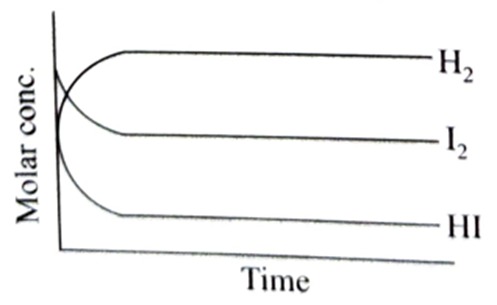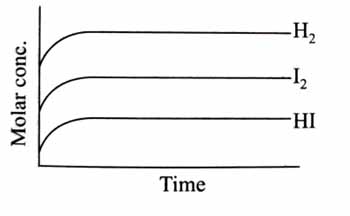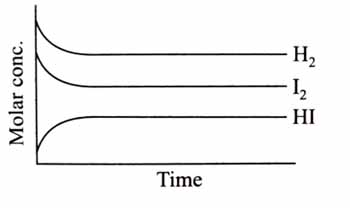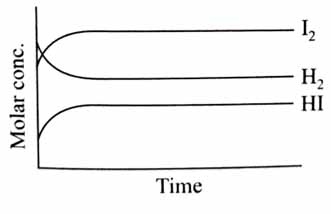Topic Question Set
Q 11
:
For the reaction,
Attainment of equilibrium is predicted correctly by: [2025]
(3)
During the time interval from start of the reaction till equilibrium, concentration of reactants ( and ) decrease and concentration of products (HI) increase. Once equilibrium is reached concentration of each species becomes constant.
Q 12
:
At temperature T, compound dissociates as having degree of dissociation (small compared to unity). The correct expression for in terms of and is [2025]
(1)
Q 13
:
Consider the fraction
The equation representing correct relationship between the degree of dissociation of (g) with its equilibrium constant is _______ .
Assume to be very small. [2025]
(1)
Q 14
:
Consider the following chemical equilibrium of the gas phase reaction at a constant temperature:
If being the total pressure, is the pressure equilibrium constant and is the degree of dissociation, then which of the following is true at equilibrium? [2025]
If value is extremely high compared to
When increases decreases
If value is extremely high compared to becomes much less than unity
When increases increases
(2)
As is constant for a constant temperature, as P increases, decreases.
Q 15
:
Consider the following equilibrium,
0.1 mol of CO along with a catalyst is present in a 2 flask maintained at 500 K. Hydrogen is introduced into the flask until the pressure is 5 bar and 0.04 mol of is formed. The is ______ (nearest integer).
Given : R = 0.08 bar
Assume only methanol is formed as the product and the system follows ideal gas behaviour. [2025]
(74)
As moles of mol
Total moles = mol
By ideal gas equation at equilibrium:
Thus:
Q 16
:
37.8 g of was taken in a 1 L reaction vessel and allowed to undergo the following reaction at 500 K
The total pressure at equilibrium was found to be 18.65 bar.
Then, = ______ [nearest integer]
Assume to behave ideally under these conditions.
Given: R = 0.082 bar L [2025]
(962)
Initial moles of
Initial pressure of
Total pressure at equilibrium = 14.35 + p = 18.65, p = 4.3 bar
Q 17
:
The equilibrium constant for decomposition of
is at 2300 K and total pressure at equilibrium is 1 bar.
Under this condition, the degree of dissociation of water is (nearest integer value).
[Assume is negligible with respect to 1] [2025]
Under this condition, the degree of dissociation of water is (nearest integer value).
(5)





